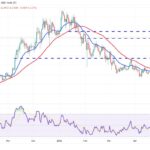In a fascinating twist within the cryptocurrency landscape, Classover Holdings, an education technology firm, made headlines earlier this month by announcing its intention to sell $400 million worth of shares to purchase Solana. This bold move sent its share price soaring from $1.15 to over $7 in just two days, before settling at around $3.69. This phenomenon, where smaller companies pivot towards digital assets for market traction, is not unique to Classover and is becoming increasingly common.
Today, GD Culture Group, valued at approximately $30 million, followed a similar path by disclosing plans to raise up to $300 million to buy Bitcoin and a lesser-known meme token themed after former President Donald Trump, sparking a 13% surge in its stock price. Meanwhile, Amber International Holdings, with a market cap of nearly $900 million, announced a $100 million allocation to a diverse array of cryptocurrencies, including Bitcoin and Ethereum.
This trend seems to mimic the playbook of corporate crypto advocate MicroStrategy, which established itself as a major player by adopting Bitcoin as its main treasury asset back in 2020. While MicroStrategy has enjoyed immense success, with its stock soaring over 3,000%, newer firms like Classover, GD Culture, and Worksport demonstrate a different approach; they often announce grand intentions to invest in cryptocurrency while lacking a substantial business history or clear strategies.
“The playbook seems straightforward: Find a buzzy crypto token, announce a purchase or strategic allocation, then ride the temporary surge in retail investor attention.”
This wave of activity indicates that microcap companies are increasingly leveraging cryptocurrency announcements to capture investor interest and drive stock prices higher—even if the actual execution of their proposed strategies remains uncertain. There is an ongoing dialogue about whether these companies can establish themselves as credible stakeholders in the crypto space or if they are merely riding the hype wave.
On the other hand, firms like the Japanese investment group Metaplanet and U.S.-based Semler Scientific appear to be taking a more serious approach to cryptocurrency by building significant Bitcoin reserves, contrasting sharply with the short-term tactics employed by new entrants. As the market continues to respond positively to crypto-related headlines, it’s likely we will see more companies attempting to harness this energy in pursuit of growth.

Impact of Crypto-Driven Stock Surges on Microcap Companies
The recent activities of microcap companies in the cryptocurrency space illustrate a growing trend that could influence investors and markets significantly.
- Classover Holdings’ Share Surge:
- Classover announced a plan to sell $400 million in shares to purchase Solana.
- The company’s stock price skyrocketed from $1.15 to over $7 before stabilizing around $3.69.
- Emerging Trend Among Microcap Companies:
- Many small companies are adopting cryptocurrency strategies, often leading to temporary spikes in stock prices.
- GD Culture Group and Amber International Holdings followed similar paths, announcing large cryptocurrency investments and witnessing immediate stock gains.
- Short-Term Gains vs. Long-Term Viability:
- Companies often make grand cryptocurrency announcements that exceed their own market value, raising questions about their commitment and financial planning.
- While companies like Classover and GD Culture see initial boosts, it remains uncertain if they can maintain these gains or deliver on their promises.
- Comparison with Established Companies:
- MicroStrategy has set a precedent by successfully integrating Bitcoin as a primary reserve asset, resulting in significant stock appreciation over time.
- New entrants like Worksport see initial stock jumps but struggle to sustain interest as their investments often fail to materialize effectively.
- Potential Risks for Retail Investors:
- Investors should exercise caution as these microcap companies leverage the crypto hype for short-term gains, often with little strategy or transparency.
- The volatility associated with these stocks could lead to significant risks, especially for retail investors drawn in by fleeting headlines.
- Long-Term Commitment Examples:
- Firms like Metaplanet and Semler Scientific demonstrate a more strategic approach, with consistent cryptocurrency investments reflecting a commitment beyond marketing hype.
- Their long-term holdings could signal a potential shift in how corporate assets are managed in the crypto era.
“As long as the market rewards crypto-related headlines with stock rallies, small companies are likely to continue jumping on the bandwagon.”
Analysis of Classover Holdings’ Crypto Strategy and Its Competitive Landscape
The recent foray of Classover Holdings into the cryptocurrency space is part of a broader trend where microcap and nanocap companies attempt to leverage the allure of digital assets. The education tech firm’s plan to sell shares worth $400 million to invest in Solana has not gone unnoticed in an increasingly competitive environment. The sharp rise in Classover’s stock price, from $1.15 to over $7, exemplifies how cryptocurrency-related announcements can trigger significant market volatility. However, this also sets a precarious precedent that marks both potential opportunities and risks for similar firms.
Competitive Advantages: Classover’s immediate stock price surge highlights the short-term benefits of integrating cryptocurrency into a company’s strategic narrative. Like Strategy (MSTR), which has seen a meteoric rise largely attributed to its bitcoin holdings, Classover and other firms seeking to mimic this approach may tap into a growing retail investor interest in cryptocurrencies as speculative bets on stock performance. Such announcements can create urgency among investors, potentially injecting liquidity and enhancing a company’s market visibility, enabling smaller firms to momentarily overshadow larger competitors.
Competitive Disadvantages: However, the rapid fluctuations in share prices, as seen with Classover’s stock settling back to $3.69, underscore the inherent volatility and risks associated with these strategies. Unlike established players like Strategy, many of these companies lack the operational history and clear commitment to cryptocurrency adoption, which might raise skepticism among discerning investors. Firms like GD Culture Group and Amber International Holdings are also entering this crowded space, which could dilute interest and create competitive pressures on firms without a robust or storied approach to digital assets.
Moreover, this trend could backfire for companies that overreach in their proposed allocations compared to their actual market valuations. The audacious attempts by Classover and GD Culture to plan substantial investments that far exceed their market caps may create doubts about their financial strategies and long-term sustainability. This uncharted territory could lead to investor disillusionment if expectations are not met or if funds become locked in volatile assets.
While microcap companies can initially capture media attention and investor enthusiasm through bold crypto investments, their long-term success relies on substantiation beyond just headlines. As the ecosystem becomes saturated with similar stories, the uniqueness of Classover’s approach may wear thin, making it more challenging to sustain momentum or attract serious investment.
Those who stand to benefit from this crypto trend are likely retail investors seeking high-risk, high-reward opportunities—likely with little concern for volatility. Conversely, existing shareholders, particularly long-term investors who prefer stable growth, may find these strategies problematic, especially if they lead to unpredictable market behavior. Furthermore, companies that truly wish to establish credibility in cryptocurrency investment must focus on genuine asset acquisition and a cohesive strategy rather than merely riding the wave of hype, which might set them apart from the crowd.

















